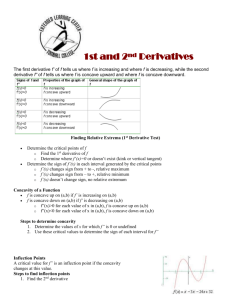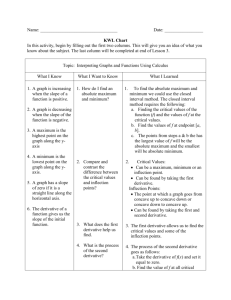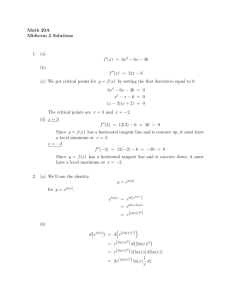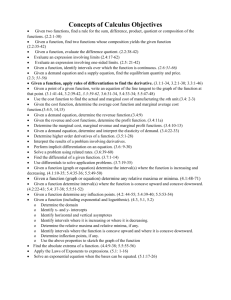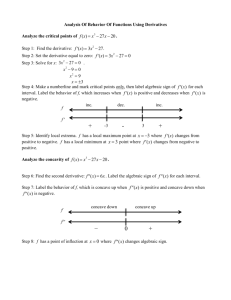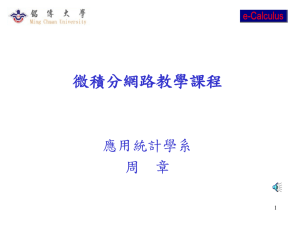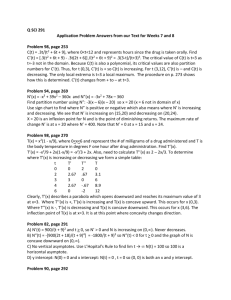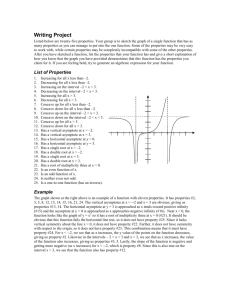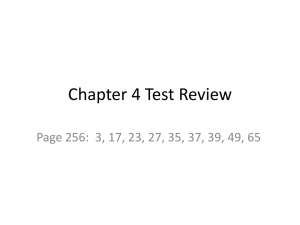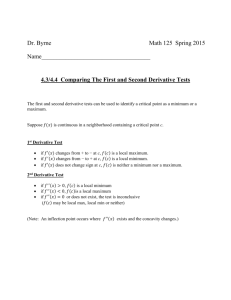Answers to Review Test 3:
advertisement
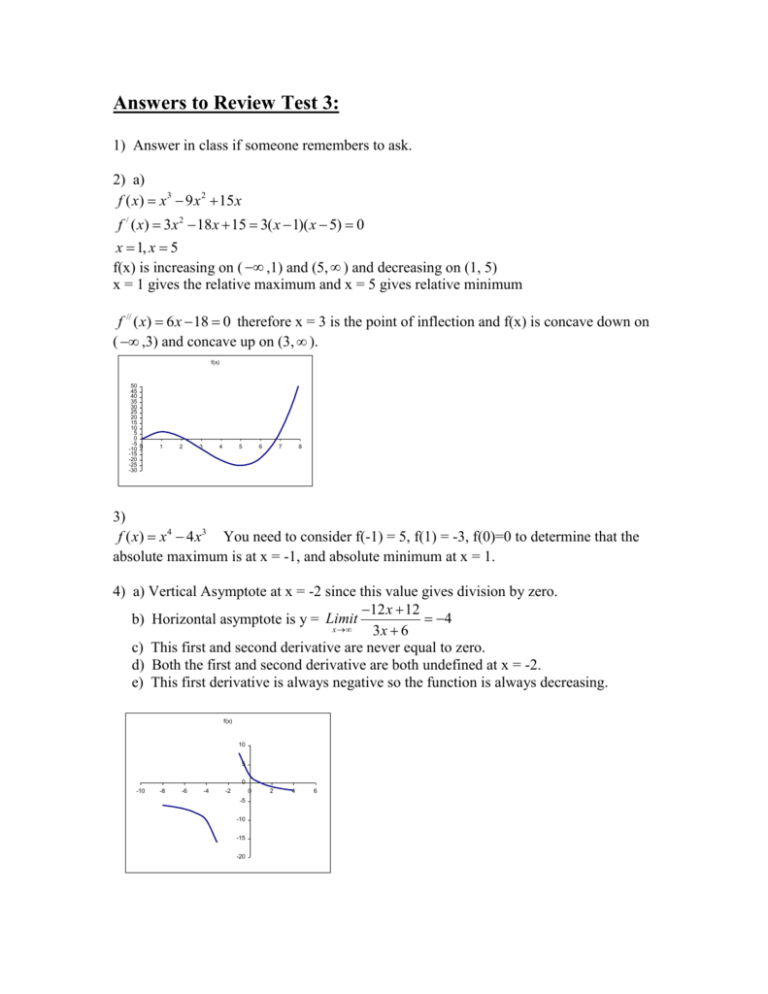
Answers to Review Test 3: 1) Answer in class if someone remembers to ask. 2) a) f ( x) x3 9 x 2 15 x f / ( x) 3x 2 18 x 15 3( x 1)( x 5) 0 x 1, x 5 f(x) is increasing on ( ,1) and (5, ) and decreasing on (1, 5) x = 1 gives the relative maximum and x = 5 gives relative minimum f // ( x) 6 x 18 0 therefore x = 3 is the point of inflection and f(x) is concave down on ( ,3) and concave up on (3, ). f(x) 50 45 40 35 30 25 20 15 10 5 0 -5 -10 0 -15 -20 -25 -30 1 2 3 4 5 6 7 8 3) f ( x) x 4 4 x3 You need to consider f(-1) = 5, f(1) = -3, f(0)=0 to determine that the absolute maximum is at x = -1, and absolute minimum at x = 1. 4) a) Vertical Asymptote at x = -2 since this value gives division by zero. 12 x 12 4 b) Horizontal asymptote is y = Limit x 3x 6 c) This first and second derivative are never equal to zero. d) Both the first and second derivative are both undefined at x = -2. e) This first derivative is always negative so the function is always decreasing. f(x) 10 5 0 -10 -8 -6 -4 -2 0 -5 -10 -15 -20 2 4 6 5) a) Revenue R = 600q – 5q2 Now find the marginal revenue and critical points in order to determine the increasing and decreasing. R / (q) 600 10q 0 and q = 60 and revenue is increasing on (0, 60) and decreasing for all q > 60. b) The ideal relative maximum occurs at q = 60 but since they are only able to make 50 bikes the realistic maximum will occur at q = 50 since revenue is increasing at that point. c) Revenue 20000 15000 10000 5000 0 0 20 40 60 80 100 120 d) Profit = -5q2 + 400q -1500 Take the derivative (marginal profit) and set it equal to zero and solve to get q = 40. Take the second derivative and verify the q = 40 is indeed the max profit. e) price = 600 – 5q = 600 – 5(40) = $400. 6) Is omitted 7) R 25q (0.95) q R / 25(0.95) q 25q(0.95) q ln(0.95) 25(0.95) q ( q ln(0.95)) 0 q ln(0.95) .05129 8) 2 f ( x) 18 x x 3 3 / f ( x) 18 2 x 2 0 x 3 f // 4 x, f // (3) 12, f // (3) 12 Therefore x = -3 is minimum and x = 3 is maximum 9) a) Vertical asymptote is x = 3 b) The first derivative is zero at x = 0 and x = 6. f(x) increases (, 0) , (6, ) and decreases on (0, 3), (3,6) c) Relative max at x = 0 and relative min at x = 6. d) f(x) is concave down on ( , 3) and concave up on (3, 6) e) no points of inflection. Graph: Graph of f(x) 18 15 12 9 6 3 -6 -5 -4 -3 -2 0 -1 0 -3 1 2 3 4 5 6 7 8 9 10 -6 -9 10) Will be done in class! 11) If production number is increased from q = 105 to 106, then TOTAL revenue is increased by $128. Use marginal analysis to estimate R(106) = R(105) + MR(105) = $1128 12) a) Profit = R – C = (408q – 4q2) – (1250 – 8q) = -4q2 +400q -1250 P / =-8q +400 = 0 so q = 50 b) P // =-8 so P is concave down and q = 50 is the maximum situation. c) price = 408 – 4q = 408 -200 = $208 d) MP(10) = -8(10) + 400 = 320, since MP is positive, Profit is increasing at q = 10 Profit 9000 7000 5000 3000 1000 -1000 0 -3000 20 40 60 80 100 13) F(x) = x 3 12 x 20 a) If x = 0 then y = 20 b) F / 3x 2 12 0 x = 2 F(x) is increasing on ( , 2) , (2, ) and decreases on (-2,2) c) Relative maximum is at x = -2 and Relative minimum is at x = 2 d) F // 6 x 0 so x = 0 is the point of inflection and F(x) is concave down on (, 0) and concave up on (0, ). e) Consider the values F(0) = 20, F(2) = 4, F(3) = 12: therefore the absolute maximum is at x = 0, and absolute minimum is at x = 2. Graph: f(x) -5 -4 -3 -2 50 45 40 35 30 25 20 15 10 5 0 -1 -5 0 -10 -15 -20 1 2 3 4 5 6 7 8 14) Profit = R – C = (1600q – q2)- ( 1500q + 500) = -q2 +100q -500 MP = -2q + 100 = 0 so q = 50. The second derivative is negative so q = 50 is the ideal maximum profit but since they are only able to make 40 bears the real max profit will occur at q = 40 and the price they need to charge is Price = 1600 – 40 = $1560. 15) q = 400 – 4p a) p dq p 4 p 160 2 E (4) The absolute value is less than 1, q dp 400 4 p 400 4q 240 3 therefore the demand is elastic at p = 40. b) To find when the demand is unit elastic set E = -1. 4 p 1 400 4 p 4 p 400 4 p 400 8 p p 50 If the price is $50 then you have unit elasticity and maximum revenue. c) Revenue is R = 400q – 4q2 and MR = 400 – 8q = 0 which gives you the maximum at q = 50. 16) N, L, N, L, N


